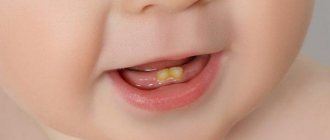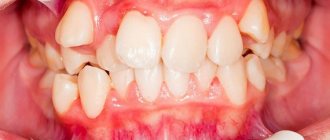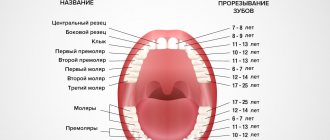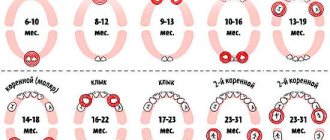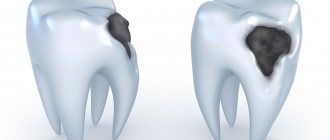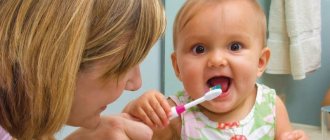The first signs of yellow teeth may appear in a child with the appearance of the first molar. At this stage, parents should be careful and seek advice from a pediatric dentist. If you exclude all factors that influence the darkening of tooth enamel, then it is quite possible that you will be able to correct the natural tone of the tooth enamel of growing teeth. These are the factors.
- Insufficient oral hygiene. If you don't supervise your baby and brush twice a day daily, plaque buildup can negatively impact the shade and formation of your baby's yellow molars.
- Correction of baby food. If a child consumes large quantities of coloring juices (carrots, pomegranates, cherries), pigment may be deposited on the hard tissue of the teeth. If the tint does not disappear within a day, then it is better to exclude such “natural” juices from your baby’s diet. The consumption of sweet and flour products is also important. It is sometimes difficult for a child to refuse sweets, but consuming sweets too often can directly affect the color of tooth enamel. Carbohydrates are a breeding ground for pathogenic bacteria, which produce acids during their life. It is these acids that destroy tooth enamel.
- Taking tetracycline antibacterial drugs. Certain medications can affect the color of enamel. This applies to both the use of medications by the baby himself and the use of medications by the mother during pregnancy. If the first signs of darkening appear during treatment of a child, you should consult a doctor and, possibly, replace the drug with another group of antibiotics.
- Enamel hypoplasia. Only the thin coating of the crown—tooth enamel—has a milky white color. Beneath it are darker tooth tissues - the so-called dentin. It is the translucency of dentin that causes the yellowish or bluish tint. If the enamel layer is insufficient, which sometimes happens in children as a pathology, then the dentin shows through quite strongly, and the teeth acquire a dirty yellow tint. It is not always possible to eliminate this fact. The dentist may prescribe an additional calcium supplement for your baby to support the development of tooth enamel. However, this is not a radical measure, so it is worth waiting until the child’s dentition is fully formed and then choosing a correction method.
- Poor quality drinking water. Large amounts of iron in water can cause yellowing of the enamel. If this situation occurs among all residents of a given region, then special purification filters for drinking water should be purchased. Otherwise, your child will have to put up with yellow teeth.
- Changes in enamel color while wearing braces. Correcting a child’s bite is a necessary and very important event. However, enhanced hygiene should be especially carefully monitored during this period. Plaque forms in the places where the braces are attached, which cannot be cleaned with a regular toothbrush and can form a yellow stain on a child’s tooth. This can lead to darkening of the enamel or even the development of dental caries. You can cope with this problem using a special irrigator designed for cleaning teeth in hard-to-reach places. Or you can visit a dentist and have your mouth professionally cleaned.
- In rare cases, yellowing of teeth can be a consequence of a general illness in the child's body. Diagnoses such as hepatitis, fluorosis, kidney disease, and serious metabolic disorders can provoke changes in the structure of the hard tissues of the teeth. In this case, the question is more about treating the root cause than its consequences.
Causes of yellow teeth
Most often, children's teeth turn yellow due to parental neglect. They must understand that they need to take care of their oral cavity from the moment the first tooth emerges. In advanced conditions, plaque removal will be required. The causes of yellowness may be hidden in acquired diseases. The color of children's crowns is negatively affected by jaundice, as brown spots appear. Also, a dark shade may appear due to problematic digestion.
As a result of mechanical damage, the enamel may crack or chip. And, as a result, yellow spots appear. The pathology is caused by hypoplasia of the enamel layer, under which there is yellowish dentin. In this case, the teeth are already yellow at the time of eruption. Factors in the development of hypoplasia include pathologies of the mother during pregnancy. After all, organs are laid down and mineralized in the womb. Precipitating factors include maternal infections and toxicosis, birth trauma, and prematurity of the infant.
Rare diseases can also be to blame for yellowness. We are talking about dentinogenesis imperfecta and amelogenesis. The first pathology develops with a congenital disorder of the dentin development process. And the second disease is associated with improper formation of the enamel layer. Most often, such anomalies are characteristic of girls. Their treatment is complex and must be started immediately after the units appear.
Eating junk food
Often, yellow teeth in a child are the result of food dyes. This situation is caused by frequent consumption of pumpkin and carrot juice. Orange dyes penetrate microcracks very easily, causing the crown to turn yellowish. Coloring vegetables, berries and fruits, for example, beets or blueberries, also work. Their bright color stays on little teeth!
It is necessary to remember the negative impact on acid units. It could be a too sour apple or applesauce, orange or lemon juice. They can cause acid necrosis. The cracks that appear are immediately filled with dyes and the crowns become dark. It should be noted that iron also affects the shade of enamel. Most often, this situation is typical for well water in rural areas where there are no filters.
A separate conversation about sweets, baked goods, candies, chewing gum with sugar. Particles of these products that remain in the mouth provide a favorable environment for bacteria and pathogenic microorganisms that settle in plaque. Here it is appropriate to remember that the most harmful food is its increased dose!
Poor oral hygiene
Children who do not know how to brush their teeth are most at risk of developing unsightly stains. Therefore, it is important to teach your child how to properly use a brush and toothpaste. It is good if parents keep this process under control. Well, when the situation is difficult, you need to have your teeth cleaned of yellow plaque by a professional hygienist. Only daily procedures at home will consolidate the results and prolong the effect.
- The first incisors are wiped with a soft bristle brush after any feeding.
- When the baby learns to hold the hygiene instrument himself, he needs to be taught the rules of brushing his teeth.
- The brush and paste are selected according to age. The dentist will provide invaluable assistance with this.
- Parents should monitor the cleaning process until 8-10 years of age.
- Children with orthodontic elements are subject to special monitoring. Monthly professional cleaning is the norm for these guys.
With improper care, unsightly plaque, stones and plaques appear. This worsens the child’s appearance and increases the risk of developing dental diseases. We are talking about caries, gingivitis, periodontal disease, and pathologies of the ENT organs.
Taking medications
Some medications cause enamel discoloration. This group of antibiotics primarily includes tetracycline and amoxicillin. If taken by a pregnant woman, it usually causes her baby's teeth to turn yellow. Often these drugs are prescribed to children themselves, even up to one year old. Their frequent use almost always contributes to darkening of the enamel. What to do? In such a situation, hygienic cleaning of the oral cavity is indicated. Professional dentistry will correct the unsightly condition. “Tetracycline teeth” can be whitened using modern technologies. Of course, such procedures should be prescribed to the child by a doctor.
Genetic predisposition
It has long been proven that the color of units is strongly influenced by genetics. If parents have dull teeth, then it is not surprising that the same yellow spots will appear on the child’s teeth. True, the factor of heredity does not occur often, so it cannot be called determining. But you shouldn’t write off genetics either. Today, more and more medical scientists are proving its importance. When diagnosing and developing a treatment program, the dentist must take into account the genetic line so that the therapy is effective.
Poor maternal nutrition during pregnancy
During the period of bearing a child, a woman must eat properly and nutritiously in order to receive valuable microelements and vitamins from food. If the diet is unbalanced, the fetus does not develop fully. From birth, such babies have thinned enamel due to the fact that even in the womb there was a deficiency of nutrients, especially calcium, vitamin and fluoride. Brown dentin will be visible through the thin layer. This causes yellow plaque on the child’s teeth. Therefore, a prerequisite for the proper development of the fetus is the rational nutrition of its mother.
To prevent the child’s teeth from deteriorating, the mother must have enough calcium and fluoride. A powerful source of calcium is sesame. The seed must be thoroughly crushed or chewed to release the beneficial trace element. Don't forget about bananas, salmon, broccoli and olive oil. To replenish fluoride reserves, you need to include avocados, carrots, cucumbers, and dates in your diet.
Is yellowness normal or pathological?
Not every yellowness should be perceived as a deviation from the norm. Sometimes, due to hereditary factors, a child’s enamel becomes more transparent than that of other children. The lack of white pigment causes the dentin to show through, resulting in darker teeth.
Some dentists are inclined to believe that it is better not to correct or whiten such enamel. At least until the child reaches adulthood and hard tissues are fully formed.
If yellow teeth are showing signs of health, the best thing you can do for your baby is to practice good oral hygiene and good nutrition.
Yellowness of teeth in a child 1-3 years old
It happens that this problem is not given due attention. Parents mistakenly believe that a one-year-old child with his baby teeth does not need a dental examination. After all, these units are a temporary phenomenon, so there will be no harm from their pathology. In reality, everything is completely different. If you do not visit the dentist in a timely manner, then problems in the form of darkening of the crowns in the future will develop into serious anomalies of the oral cavity. What should parents do?
- Once the incisors appear, they need to be wiped with a damp cloth after feeding.
- When your child turns 1 year old and has 8 units, start cleaning them with a toothbrush without toothpaste. It should be small in size with nice bristles.
- After the child turns 2 years old, begin to teach him to be independent in matters of oral hygiene, then at 2.5 years he will be able to carry out this procedure himself.
Consult your doctor about the choice of baby toothpaste. After all, it is very important to approach it correctly. Do not use products that are oversaturated with flavors and dyes.
How to prevent yellowing of teeth: preventive measures
To avoid the question of how to get rid of yellow plaque, it is better to prevent the problem. As already mentioned, you should give up smoking, carbonated drinks, and coffee. Drinks containing coloring pigments are best consumed through a straw. It is important to neutralize the effect of acids on enamel. To do this, after eating acid-containing foods, you need to rinse your mouth with clean water or drink it or milk. You should also avoid snacking between main meals. This promotes more effective leaching of acids with saliva.
Regular teeth cleaning is one of the main conditions for maintaining a beautiful smile. It is necessary to use dental floss and mouthwash. If you experience dry mouth, you should consult your doctor. Fluoride-containing drugs are taken under strict control.
Yellow plaque in children over 7 years old
Deposits discovered during school age are most often associated with improper tooth brushing procedures. It is important that a suitable brush is selected taking into account the level of sensitivity of the gum tissue. Special care is not required when performing routine procedures systematically. True, if the situation is seriously advanced, then you cannot do without a visit to the dentist. When a child is 8 years old or older, teeth cleaning using the Air Flow method is prescribed, if necessary. This procedure is safe and painless.
A harbinger of pathology is bad breath and a slippery coating on the crowns and gums. A timely cleaning procedure will prevent the mineralization of soft plaque, which often happens at this age. Refined and soft carbohydrate foods should be limited. Such products get clogged into the interdental spaces. It is useful to give children solid vegetables and fruits, for example, carrots or apples. Remember that proper hygiene is the key to oral health and the best remedy against yellow discolouration!
Whitening pastes
Such pastes and gels can be freely purchased in pharmacies, or ordered on the recommendation of your doctor. It is not advisable to use them constantly, since they still have some effect on the enamel. It is best to periodically alternate whitening compounds with medicinal or gum strengthening ones.
With your dentist's approval, you can try home whitening using trays and whitening gels. Such procedures can significantly change the tone of tooth enamel towards white. However, you should not get carried away with this method, since it increases tooth sensitivity and, if used incorrectly, can damage tooth enamel.
What to do with a child's yellow teeth
The choice of treatment technology depends on the disease and the phase of its development. Light yellowness can be removed with special pastes. More severe cases require professional cleanings by a dentist. For older teenagers, ultrasonic teeth cleaning is used. If there is a serious need to use a skeler, the procedure is carried out delicately and with caution. The cost of procedures in our center is affordable, as we always pursue a reasonable pricing policy.
At the appointment with our dentist, the child will be mentally prepared for therapy in order to prevent fear. The level of oral hygiene is determined by special indicators. Professional cleaning procedures are painless. This can be a rotating brush, which works well on both the oral and vestibular sides. After such manipulations, as a rule, a hygiene lesson is conducted in a playful way.
Effective dental methods for teeth whitening
If you are really interested in how to whiten your teeth, it is better to go to a doctor and take into account his recommendations. Today dentistry offers different methods to solve the problem:
- Mechanical cleaning is the simplest method, carried out using special attachments. As a result of the procedure, soft and hard dental deposits are eliminated. This technique helps prevent caries and gum disease.
- Hardware cleaning. How to clean your teeth and eliminate their yellowness? During the procedure, the doctor removes plaque using an ultrasound machine. Special attachments allow you to remove supragingival and subgingival deposits. After the procedure, the natural shade of the teeth returns.
- Bleaching. There are different ways to lighten tooth enamel. This can be chemical, intracanal, laser and photobleaching. These techniques differ in cost and effectiveness.
- Veneers. If you are looking for a way to remove dental defects, you should consider the option of special onlays for the front teeth. Veneers allow you to get a perfectly even and, what is important in case of yellow discoloration, a snow-white smile. This technique does not involve a strong impact on tooth enamel - grinding, laser treatment, etc.
Modern techniques make it possible to lighten enamel with varying degrees of yellowness. The procedures do not cause pain in the patient and are performed quickly enough. The doctor will recommend the most suitable technique for you.
Preventive measures
To prevent yellowing of teeth, it is important to carry out all hygiene measures efficiently and on time. We are talking about twice daily cleaning of units, even dairy ones. It’s good if parents take their child to the dentist once every 60 days. The basis of dental health is a balanced and proper diet. As for the frequency of professional cleaning, it should be carried out once every six months. Don't forget to change your toothbrushes and toothpastes on time. Teach your child to oral hygiene from an early age, then dental problems will be minimized.
Features of superficial caries
Among the main distinctive features of superficial carious damage to teeth in children in comparison with other forms of pathologies, the following should be noted:
- only the enamel layer is affected by pathogenic formations. The dentin remains intact. With timely treatment, the risks of complications are minimal;
- the occurrence of an acute reaction to external stimuli, for example, sour and sweet foods, low and high temperatures;
- if superficial caries is diagnosed in children, treatment can be carried out without tissue preparation;
- Most often, the superficial form occurs in children aged 3-4 years and in adolescents.
Note! Initial caries and superficial caries are two completely different forms. The first appears as a small spot, the second occurs in the absence of treatment. It can be recognized by the presence of small-sized carious cavities.
How to eliminate yellow teeth[1]
To prevent unhealthy yellow teeth, you need to:
- regular and proper care;
- rejection of bad habits;
- eating calcium-rich foods;
- control over the composition and quality of drinking water.
There are toothpastes for home use that can both remove yellow plaque and lighten the natural tone of the enamel. However, many of them contain harsh abrasive components that are harmful to teeth, so you should choose safe, innovative products with a gentle cleansing formula. These toothpastes lighten teeth when used regularly. If you want an immediate effect, you can use an optical whitening paste.
If these measures do not lead to lasting results, you should additionally consult with your dentist. Cleaning and professional whitening procedures are possible only after complete sanitation of the oral cavity.
It should be noted that even ordinary professional cleaning brightens teeth by 1-2 tones by removing plaque, deposited pigments and tartar. It is carried out using manual, ultrasonic and other methods, and at the end the teeth are polished with special pastes to remove roughness. The result lasts about six months.
If you need to significantly lighten your teeth, you can bleach . The procedure involves applying a special composition to the teeth, usually based on hydrogen peroxide. For this purpose, brushes, applicators or mouth guards (standard or custom-made) can be used. Further, depending on the technique chosen by the doctor, the composition is kept on the teeth in its original state (simple chemical whitening) or activated using high-energy light sources. In both cases, the effect on the teeth lasts no more than 20 minutes. The table provides summary data on the most common methods of professional whitening [1].
| Peroxide content in whitening composition | Light exposure | Lightening degree | Harm to teeth | Price | |
| Chemical bleaching | High | Absent | 5-7 tones | Strong | Low |
| Photobleaching | Average | Average | 8-10 tones | Average | Average |
| Laser whitening | Low | Intensive | 10-12 tones | Weak | High |
The effect of the procedure can last for several years, but it has a number of contraindications and side effects.
Principles of treatment of superficial caries
When superficial caries is detected in children, treatment should be aimed not only at eliminating formations on the tooth enamel, but also at preventing the re-development of the pathology. To prevent complications, comprehensive and immediate therapy is necessary.
When talking about treatment, it should be understood that it is just beginning in the dentist’s office, and it will also need to be continued at home using special means and traditional medicine recipes.
Features of treatment in the pediatric dentist's office
If baby teeth are damaged by caries, then it is quite possible to treat them conservatively without the use of drills, which almost every child is afraid of. Modern dentistry offers more gentle and comfortable methods:
- Children under 3 years of age undergo silvering or deep fluoridation of their teeth. If the enamel has already been damaged by caries, it is cleaned of plaque and treated with a laser. If necessary, cracks in the chewing and frontal teeth are sealed;
- at the age of 3 to 5 years, ozone therapy can be performed to eliminate the first stage of superficial caries, and in case of major complications, treatment is carried out using the method of depophoresis. Its essence lies in the introduction directly into the root canals of a special composition with calcium and copper;
- Children from 5 to 9 years old undergo filling. Glass ionopolymers or colored compomers are used for fillings;
- Children aged 9 to 12 years already have molars and adult technologies can be used to treat them with minimal trauma. But in most cases, therapy of chewing teeth is carried out by sealing fissures.
When superficial caries in children requires complex dental procedures, local anesthesia is mandatory before such procedures are performed. If removal is necessary, such an intervention can be performed under intravenous anesthesia.
Treatment at home
Along with professional treatment of caries by a pediatric dentist, proper oral care at home will also be required to obtain an effective result. For this purpose, special rinsing compositions and toothpastes with anti-caries effects are used.
For children under 4 years of age, dental and oral care products should not contain fluoride. The therapeutic effect is provided by antibacterial active components and calcium ions.
Children over 4 years old are allowed hygiene products containing fluoride, only the concentration of the element must be minimal.
LACALUT kids, PresiDENT Baby, SILPA Putzi, Splat junior are considered good toothpastes for children. You need to brush your teeth with them twice every day. Among the rinses, Drakosha for children, Active Kids, and LACALUT Teens have proven themselves well. When treating caries with such solutions, it is necessary to rinse your mouth after every meal and always before going to bed.
In addition to professional medications, you can also use remedies prepared according to alternative medicine recipes:
- An infusion of chamomile is perfect as a rinse. To do this, pour a glass of boiling water into 1 tbsp. l. dried flowers, leave and cool to room temperature;
- a weakly concentrated solution of sea salt has a positive effect on the condition of teeth. Dissolve 0.5 teaspoons of salt in a glass of water and use for rinsing.
Important! Rinse aids can only be used after the child reaches 1.5-2 years of age, when he can already rinse and spit out liquid on his own, rather than swallow it.
